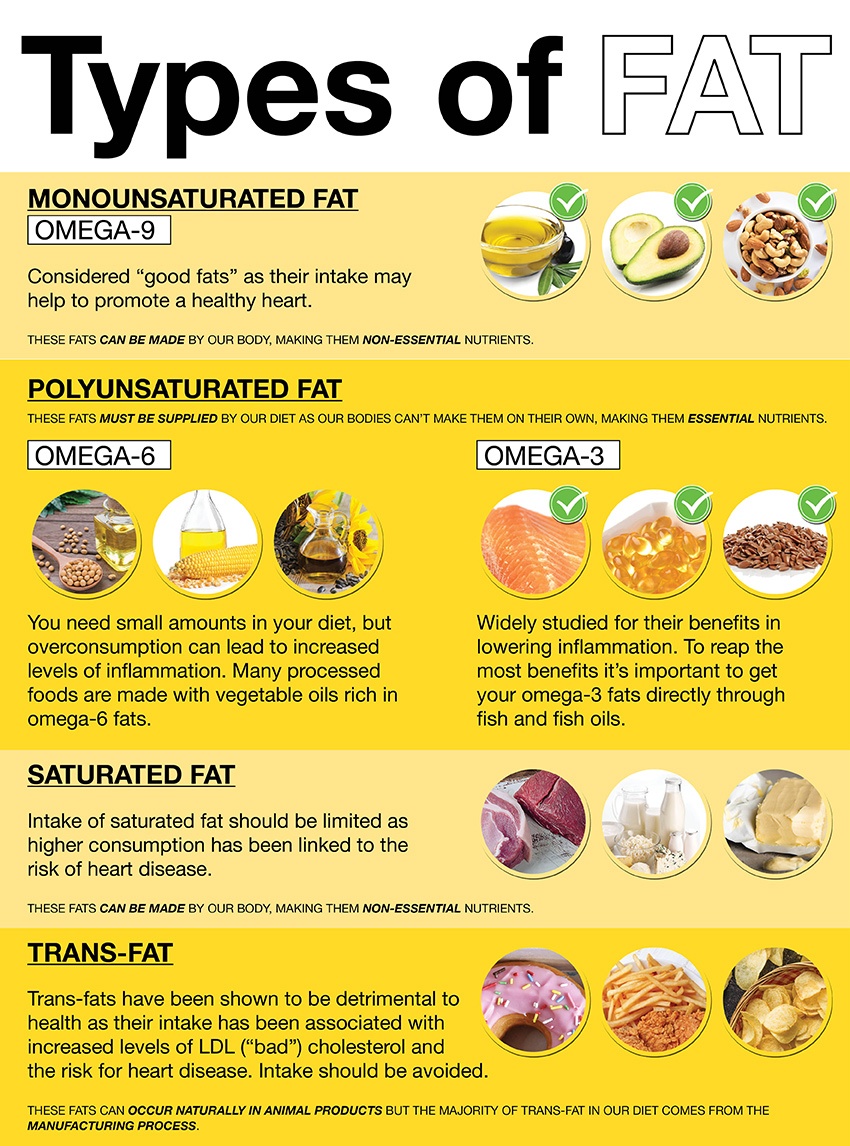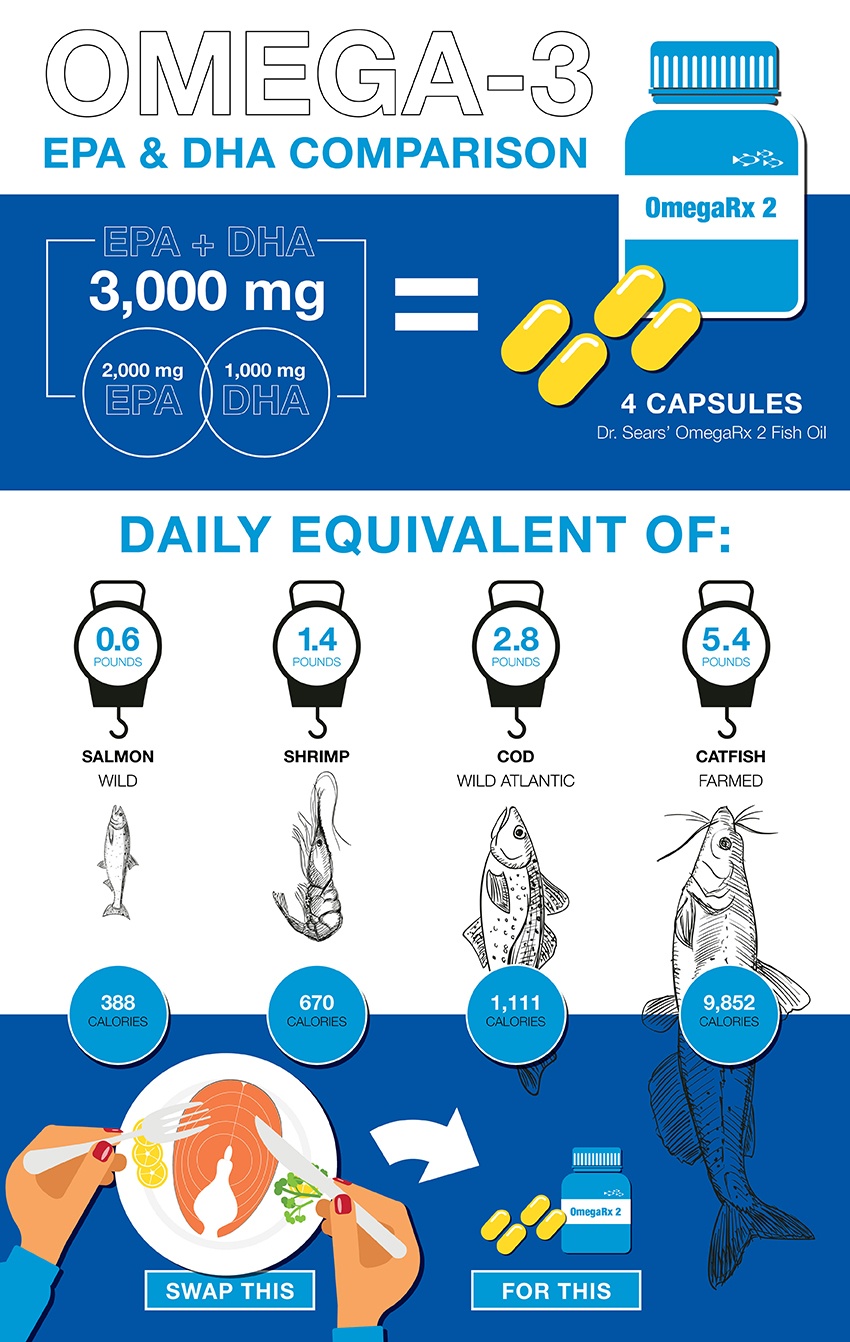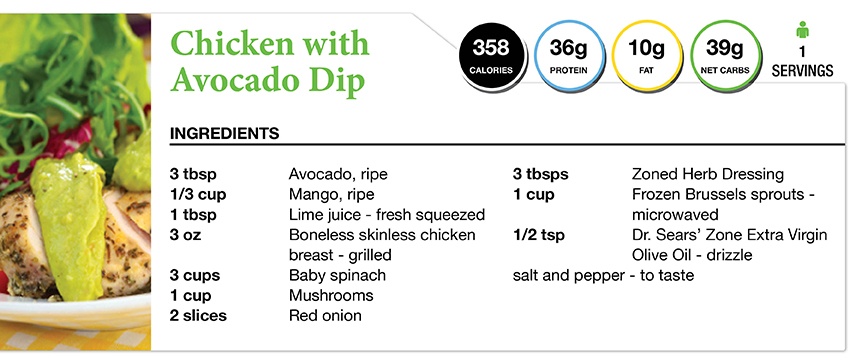In the early 90s dietary fat was considered a “villain” and carbohydrates were the “heroine”. The thinking was that by lowering fat in the diet you could decrease the risk of heart disease. Many began to believe that eating fat, made you fat. As a result the food industry began replacing fat with carbohydrates in food products leading to greater consumption of low-fat, high-sugar foods (think Snackwells cookies).
Guide to Fat
While fat does provide more calories per gram (9kcal/gram) compared to carbohydrate and protein (4kcals/gram), we now know it’s not as simple as swapping out one ingredient for another. In fact there are many benefits to be gained by consuming the right types of fat, the key is moderation. Here we’ll break down what fats are, why you need them, and what to know when choosing them.
What is Fat and Why We Need It?
- Fat is a major energy source for producing energy (ATP) as needed in the body (9kcal/gram)
- Involved in cell signaling and gene expression
- An important regulator of inflammation, insulin action, and brain function
- Sends hormonal signals to the brain saying you are full and satisfied
- Slows the rate at which carbohydrates enter the blood stream, helping to minimize spikes in blood sugar
- Helps with the absorption of fat-soluble vitamins (A,D,E,K)
- Major contributor to cell structure and function

Types of Fat
Monounsaturated Fat (Omega-9): Monounsaturated fats are fatty acids that contain one (mono) double bond and are liquid at room temperature. These fats can be made by our body, making them non-essential nutrients. You might also hear them referred to as omega-9 fats. Monounsaturated fats are considered “good fats” as their intake may help to promote a healthy heart.
Sources: Oils (Olive oil, high-oleic safflower and sunflower oil), avocado, and nuts.
Polyunsaturated (Omega-3 and Omega 6 Fats): Polyunsaturated fats include both omega-6 fatty acids and omega-3 fatty acids. Going back to chemistry these fatty acids contain more than one (poly) double bond and are liquid at room temperature. Polyunsaturated fats are considered essential, meaning they must be supplied by our diet as our bodies can’t make them on their own.
Omega-6 Fats: Linoleic Acid is an essential omega-6 fat that has the ability to be made into Arachidonic Acid, a precursor to hormones (prostaglandins, thromboxanes and leukotrienes) linked to inflammation. You need small amounts in the diet, but overconsumption can lead to increased levels of inflammation. Since many processed foods are made with vegetable oils rich in omega-6 fats, most Americans are overconsuming these fats in their diets.
Sources of omega-6 fatty acids: nuts, seeds, vegetable oils (sunflower, corn, cottonseed, soybean)
Omega-3 Fats Alpha-linolenic acid (ALA) is an essential omega-3 fat (found flaxseed, canola oil, nuts) that has the ability to be converted into EPA and DHA. EPA and DHA have been widely studied for their anti-inflammatory benefits. Only about 1-10% of the omega-3s in ALA are converted into EPA and DHA, so to reap the most benefits it’s important to get EPA and DHA directly through fish and fish oils.
Sources of omega-3 fatty acids: Fatty fish and fish oil, nuts, flaxseed.
Saturated Fats: Saturated Fat can be made in the body (non-essential) and can be used for structural and metabolic functions. Intake of saturated fat should be limited as higher consumption has been linked to the risk of heart disease. Studies show that replacing saturated fats with mono and polyunsaturated fats may reduce the risk of heart disease.
Sources: Whole milk, cream, butter, cheese, meat and oils (coconut oil, palm oil, and palm kernel oil).
Trans-Fat: Trans-fats can occur naturally in animal products (milk, butter, cheese, meat), but the majority of trans-fat in our diet comes from the manufacturing process. This is done through a process called hydrogenation where hydrogen is added to vegetable oil, making them go from a liquid at room temperature to a solid. You’ll often see trans-fats listed on labels in the form of partially hydrogenated oils. As of June 18, 2018 trans-fats can no longer be produced, but you may still see them in marketplace through the start or 2020 to give manufacturers time to get them out of circulation. Trans-fats have been shown to be detrimental to health as their intake has been associated with increased levels of LDL (“bad”) cholesterol and the risk for heart disease. Intake should be avoided.
Sources: Listed as "partially hydrogenated vegetable oil", found in many processed foods and most bakery products (cookies, cakes, crackers and pastries).
Fat Recommendations for the Zone Diet
We recommend fat consumption come primarily from heart-healthy monounsaturated fat and anti-inflammatory omega-3 fats rich in EPA (Eicosapentaenoic Acid) and DHA (Docosahexaenoic Acid). Simultaneously we suggest reducing the consumption of vegetable oils rich in omega-6 fats, and avoid intake of fats rich in arachidonic acid, known to be pro-inflammatory.
When making a Zone meal we recommend aiming for one that is under 12 grams of fat with 25 grams of protein, about 35 grams of net carbs (total carbohydrates minus fiber) and approximately 400 calories or less. When you have the right amount of fat, balanced with protein and low glycemic carbohydrates, it helps minimize hungry and fatigue for up to 4-5hours. 
How Much Omega3 Should You Be Getting Each Day
EPA and DHA are the two omega-3 fatty acids that have been most widely studied in the literature for their clinical benefits in lowering inflammation. Dr. Sears recommends individuals consume at least 3000mg of EPA and DHA daily for wellness. It would be difficult to meet this recommended intake of EPA and DHA from eating fish alone. While there are benefits to consuming fish, the current recommendations for adults (excluding pregnant woman and children) is to consume no more than 12 ounces of fish per week to minimize intake of contaminants like mercury, polychlorinated biphenyls (PCBs), and dioxins. This is why we recommend OmegaRx 2 as it’s highly purified to remove as many PCBs as possible making it your best choice for purity and potency.

Try our zesty avocado dip as a dressing or on the side with chicken and spinach salad.

Instructions:
- In a blender blend together avocado, mango and lime juice.
- Grill the chicken breast and top with avocado dressing (or on the side).
- Serve with spinach salad topped with Zoned Herb Dressing (made ahead of time) and Brussels sprouts drizzled with extra virgin olive oil, salt and pepper.






Let Us Know What You Thought about this Post.
Put your Comment Below.